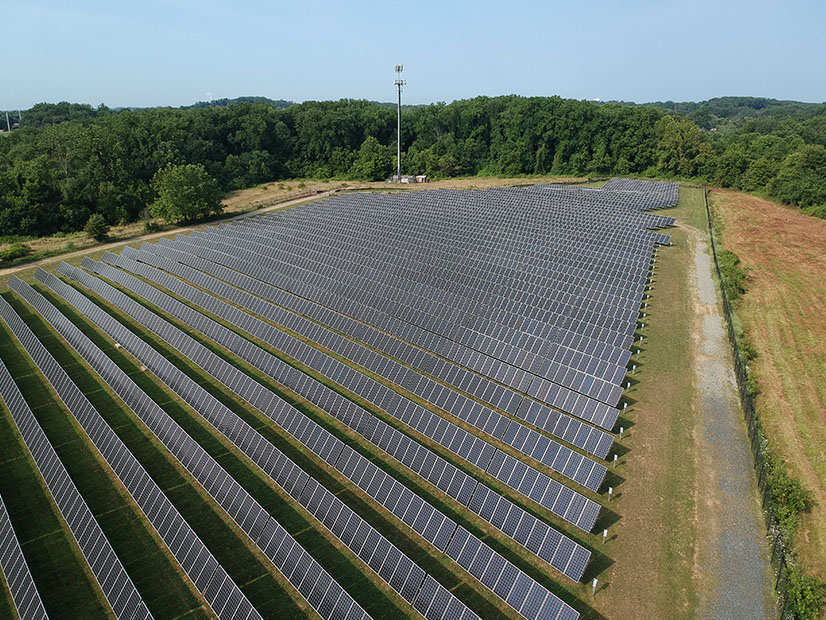The Maryland Public Service Commission last week proposed expanding the state’s community solar pilot program by increasing its maximum capacity and broadening the types of sites eligible for development.
The seven-year pilot currently allows about 417 MW of community solar capacity — or about 3.25% of the state’s utilities’ 2015 peak demand. Under the revision, the cap would be raised to 4.5% of the 2015 peak demand, which could add another 167 MW of potential capacity to the program.
But, so far, only about 20 projects totaling 40 MW are online, according to Phillip VanderHeyden, the PSC’s assistant executive director.
Other revisions would add clean-fill sites — essentially former construction sites containing no hazardous materials — to the list of eligible properties and establish a waiver process for co-locating multiple low- and moderate-income (LMI) projects on the same parcel of land.
Commissioner Michael Richard on Aug. 24 said that “sensitivities toward equity have been heightened considerably since 2015,” when the law enabling the program was passed. “We must heed the legislative findings that it is in the public interest to allow low- and moderate-income customers to enjoy all the benefits of solar energy and net metering.”
While approved by the commission, the revisions will not be finalized or go into effect until they are reviewed by the state legislature and go through another round of public comment, according to an email from the PSC.
Still, project developers are enthusiastic about the expanding opportunities the revisions could create. “We’re developing community solar projects across Maryland, and the response from residents has been fantastic,” Kate Colarulli, chief of staff at CleanChoice Energy, wrote in an email to NetZero Insider. “We expect all our projects to be viable and fully subscribed.”
Arcadia, another project developer, offers community solar subscriptions that Vice President and General Manager Joel Gamoran said are “consumer-friendly,” with no credit checks and no long-term contracts. The company “has new capacity available in all [utility service territories] in the state. We’re primarily focused on [Baltimore Gas and Electric] and Pepco, where we have new projects turning on this fall,” he said.
An Expanding Market
Community or shared solar projects provide access to solar for individuals and groups who may not want or be able to put panels on their roofs, such as apartment dwellers or homeowners with heavily shaded roofs. Under Maryland’s community solar regulations, power from projects built in a specific utility’s service territory is shared among a group of “subscribers” who receive a credit on their bill for a portion of the power produced.
Across the U.S., 40 states now have at least one community solar project, and 20, including Maryland, have specific community solar laws. In a November 2020 report from the National Renewable Energy Laboratory, Maryland was identified as one of a handful of states working to expand their programs. The state is “currently not in the top 10 community solar states by capacity but will likely rise in ranking as more projects are accepted and become operational,” the report says.
Originally intended to run for three years, the regulations for the pilot program were finalized in July of 2016, and the program rolled out in 2017. The program was extended to seven years in 2019, and will now run through 2024, with data collected to evaluate its impact on Maryland’s grid.
The program is set up with capacity carve-outs for LMI projects and brownfield projects — about 30% each — with the remaining 40% open. For example, Pepco was originally allocated 50 MW for the first few years of the pilot, with 15 MW each for brownfield and LMI projects and 20 MW in the open category, according to the PSC website.
In addition, developers receive funding from the state to ensure long-term, significant bill discounts for LMI customers who subscribe to a community solar project.
“Everyone who signs up for a community solar project receives energy credits on their electricity bill,” Common Energy CEO Richard Keiser said. “If you are an LMI subscriber, and your share of those credits is $100, then you would keep $25, and Common Energy would invoice you $75 and give that money to the project owner. In this way, every LMI subscriber receives a perpetual 25% discount on the credits.”
The company currently manages seven projects in all four utility territories in Maryland — BG&E, Potomac Edison, Delmarva Power and Pepco — with a total of more than 1,300 subscribers, Keiser said.
Eric LaMora, director of community solar at Nautilus Solar Energy, said his company recently opened a 1.8 MW community solar project in Kingsville, a small town north of Baltimore. The project is serving 293 households, including 157 LMI residents, he said.
Like Common Energy, Nautilus guarantees a 25% discount for LMI subscribers; other customers are guaranteed to save 10% annually, he said.
“All Nautilus projects in Maryland are fully subscribed,” LaMora said. “Continuing the Maryland community solar program and adding capacity and new projects each year will allow Nautilus to offer affordable and equitable solar power to additional Maryland households who would not normally have access to clean energy.”
